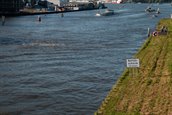What makes a water system vulnerable to climate change?
One water system is more vulnerable to the effects of climate change than another. A “resilient” water system is not vulnerable or hardly vulnerable at all, as opposed to a “highly vulnerable” system. Between resilient and highly vulnerable, a wide range of variations exist. How do you know how vulnerable a water system is? This depends on its various characteristics, which this page explains.
Do you know how vulnerable a water system is to the impact of climate change and which characteristics are responsible? Only then will you know whether it will be necessary to combat any negative effects on water quality. And then you will be able to identify the water quality measures that can help.
Characteristics of water systems
A characteristic of a water system can be, for example, that it heats up quickly because of its shallow depth. Another characteristic can be poor water through-flow in the system. Both characteristics render the system vulnerable to the development of (blue-green) algae or duckweed during warm periods. Many different characteristics can have a negative impact on water quality as a result of climate change. The Guide to Water Quality Stress Tests has been developed to gain proper insight into such matters. The stress tests distinguish three types of characteristics:
- System characteristics: these characteristics determine the appearance of the water and its position in the landscape. Examples are soil type, depth and percentage of open water.
- Pressure factors: these factors determine which common bottlenecks are prevalent in or around a water system. Examples are leaf fall in the water, dog poo and leisure boating.
- Condition: characteristics relating to the condition of the water system, such as complaints about stench, colour or dead fish, or the concentrations of salt, oxygen or duckweed in the water.
There are a great many characteristics to consider. Furthermore, the characteristics can differ within a system and many of them are inter-related. For that reason, in its Urban Water Quality, Climate and Adaptation tools, the National Water and Climate Knowledge and Innovation Programme consortium opted for a simplified representation of the various characteristics for urban areas. In the Urban Water Quality, Climate and Adaptation tools, the characteristics are divided into six indicators: nutrient content, through-flow, water temperature, oxygen content, salt content and pollution. These indicators provide a basis for getting a grip on common problems in urban areas. A full list of characteristics is provided in appendices to the Guide to Water Quality Stress Tests: Appendix 3, Initial Analysis: required input parameters, and Appendix 4, Initial Analysis: other parameters. The six Urban Water Quality, Climate and Adaptation indicators have also been incorporated into the Guide.
The changing climate can cause changes in the physical or chemical characteristics of urban surface water. In addition, climate change can affect every living thing in the water. This impact involves the biological effects. More information on the physio-chemical and biological effects on water quality is provided in the section on “How does climate change affect water quality and aquatic life?”
Indicators dependent on control variables
The six Urban Water Quality, Climate and Adaptation indicators depend on various factors, i.e. the control variables. The water quality in a water system is therefore dependent on these indicators, which in turn are affected by several underlying control variables. Click on any of the six indicators below for more information on that particular indicator and the control variables that may affect it.
Note: the indicators and control variables presented here are not the only ones. Ecosystems consist of complex interactions between a wide range of biological and physio-chemical factors. This simplified division into six indicators is intended to create a clear-cut overview to be used for practical purposes. For those who require an overview of all the characteristics that may be relevant to a stress test of water quality, such a list is provided in STOWA's Guide to Water Quality Stress Tests.
Rather than clicking on the above indicators, you could also look at the knowledge document Urban Water Quality, Climate and Adaptation (pdf, 13 MB). This interactive document contains a visual overview, which easily leads you to the information relevant to your own question or issue.
